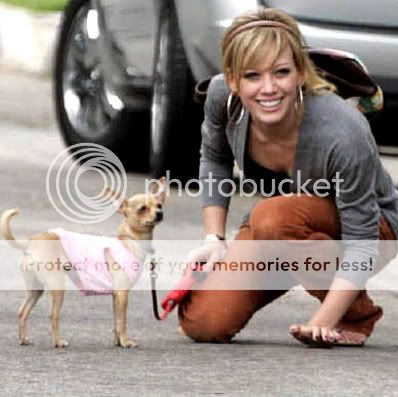Both boxers and chihuahuas are on the AKC Top 10 Most Popular Dogs list - Written by breed-specific experts Karla Spitzer and Joan Hustace Walker The Everything Chihuahua Book is an all-encompassing guide to this popular dog! Pet expert Joan Hustace Walker helps readers learn the basics of this little and lively breed, including temperament, housetraining, and obedience. Includes advice and instruction on how to: - Find a reputable breeder - Groom like a pro - Ensure good nutrition - Care for an older chihuahua
Showing posts with label Chihuahua breed. Show all posts
Showing posts with label Chihuahua breed. Show all posts
Will a Chihuahua Actually Eat Taco Bell?
The breed is the smallest of all dogs and has a long history in Mexico, named after the state of Chihuahua. But if the dogs have some sort of mystical genetic memory, surely they would turn up their noses at a bastardization of their native cuisine! In the name of science, we decided to find out: Will a Chihuahua actually eat Taco Bell?
Exhibit B: "Food" procured from Taco Bell. While purchasing the samples for this experiment, we told the counterwoman we couldn't eat onions, because the vegetable is bad for dogs. She looked at us like we were insane and assured us that no onion came within miles of the stuff.
Left to right we have a crunchy ground beef taco; a chalupa supreme with steak; and nachos supreme, topped with beans, ground beef, cheese, and sour cream.
We arranged the food and put Sammy down in front of it, equidistant from all three dishes to see which fake Mexican snack he would prefer, hypothesizing that he would go for the chalupa, on the strength of the steak.
Sammy looked totally freaked out. He circled the food dubiously several times, as though he didn't want to get too close. "What the hell is this stuff?" he seemed to be thinking. It was a far cry from "Yo quiero Taco Bell."
But then he inched closer, and stuck his muzzle into the nachos. Chomp-chomp-chomp, slowly at first but then with greater enthusiasm. He paused for a moment to consider the chalupa, but didn't seem particularly interested in eating it. As for the taco, it seems that Sammy has his standards, and crunchy beef tacos do not even merit a sniff.
Sammy's regular treats are dried liver bits. We wondered just how much he liked those nachos supreme -- would he rather eat Taco Bell than his beloved liver cookies?
Ah, yes. Once exposed to the Taco Bell, Sammy was like an addict on the make, spurning his healthier treats for a few more bites of the nachos, until it was removed from under his nose.
Conclusion: Yes, a Chihuahua will eat Taco Bell. And Chihuahuas prefer nachos.
Chihuahua Breed Standard
General Appearance
A graceful, alert, swift-moving compact little dog with saucy expression, and with terrier-like qualities of temperament.
A graceful, alert, swift-moving compact little dog with saucy expression, and with terrier-like qualities of temperament.
Size, Proportion, Substance
Weight – A well balanced little dog not to exceed 6 pounds. Proportion – The body is off-square; hence, slightly longer when measured from point of shoulder to point of buttocks, than height at the withers. Somewhat shorter bodies are preferred in males. Disqualification – Any dog over 6 pounds in weight.
Weight – A well balanced little dog not to exceed 6 pounds. Proportion – The body is off-square; hence, slightly longer when measured from point of shoulder to point of buttocks, than height at the withers. Somewhat shorter bodies are preferred in males. Disqualification – Any dog over 6 pounds in weight.
Head

A well rounded "apple dome" skull, with or without molera. Expression – Saucy. Eyes - Full, round, but not protruding, balanced, set well apart-luminous dark or luminous ruby. Light eyes in blond or white-colored dogs permissible. Blue eyes or a difference in the color of the iris in the two eyes, or two different colors within one iris should be considered a serious fault. Ears – Large, erect type ears, held more upright when alert, but flaring to the sides at a 45 degree angle when in repose, giving breadth between the ears. Stop – Well defined. When viewed in profile, it forms a near 90 degree angle where muzzle joins skull. Muzzle – Moderately short, slightly pointed. Cheeks and jaws lean. Nose – Self-colored in blond types, or black. In moles, blues, and chocolates, they are self-colored. In blond types, pink noses permissible. Bite – Level or scissors. Overshot or undershot, or any distortion of the bite or jaw, should be penalized as a serious fault. A missing tooth or two is permissible. Disqualifications – Broken down or cropped ears.

A well rounded "apple dome" skull, with or without molera. Expression – Saucy. Eyes - Full, round, but not protruding, balanced, set well apart-luminous dark or luminous ruby. Light eyes in blond or white-colored dogs permissible. Blue eyes or a difference in the color of the iris in the two eyes, or two different colors within one iris should be considered a serious fault. Ears – Large, erect type ears, held more upright when alert, but flaring to the sides at a 45 degree angle when in repose, giving breadth between the ears. Stop – Well defined. When viewed in profile, it forms a near 90 degree angle where muzzle joins skull. Muzzle – Moderately short, slightly pointed. Cheeks and jaws lean. Nose – Self-colored in blond types, or black. In moles, blues, and chocolates, they are self-colored. In blond types, pink noses permissible. Bite – Level or scissors. Overshot or undershot, or any distortion of the bite or jaw, should be penalized as a serious fault. A missing tooth or two is permissible. Disqualifications – Broken down or cropped ears.
Neck, Topline, Body

Neck – Slightly arched, gracefully sloping into lean shoulders. Topline – Level. Body – Ribs rounded and well sprung (but not too much "barrel-shaped"). Tail – Moderately long, carried sickle either up or out, or in a loop over the back with tip just touching the back.
(Never tucked between legs.) Disqualifications – Docked tail, bobtail.

Neck – Slightly arched, gracefully sloping into lean shoulders. Topline – Level. Body – Ribs rounded and well sprung (but not too much "barrel-shaped"). Tail – Moderately long, carried sickle either up or out, or in a loop over the back with tip just touching the back.
(Never tucked between legs.) Disqualifications – Docked tail, bobtail.
Forequarters
Shoulders – Lean, sloping into a slightly broadening support above straight forelegs that set well under, giving free movement at the elbows. Shoulders should be well up, giving balance and soundness, sloping into a level back (never down or low). This gives a well developed chest and strength of forequarters. Feet – A small, dainty foot with toes well split up but not spread, pads cushioned. (Neither the hare nor the cat foot.) Dewclaws may be removed. Pasterns – Strong.
Shoulders – Lean, sloping into a slightly broadening support above straight forelegs that set well under, giving free movement at the elbows. Shoulders should be well up, giving balance and soundness, sloping into a level back (never down or low). This gives a well developed chest and strength of forequarters. Feet – A small, dainty foot with toes well split up but not spread, pads cushioned. (Neither the hare nor the cat foot.) Dewclaws may be removed. Pasterns – Strong.
Hindquarters
Muscular, with hocks well apart, neither out nor in, well let down, firm and sturdy. Angulation – Should equal that of forequarters. The feet are as in front. Dewclaws may be removed.
Muscular, with hocks well apart, neither out nor in, well let down, firm and sturdy. Angulation – Should equal that of forequarters. The feet are as in front. Dewclaws may be removed.
Coat
In the Smooth Coats, the coat should be of soft texture, close and glossy. (Heavier coats with undercoats permissible.) Coat placed well over body with ruff on neck preferred, and more scanty on head and ears. Hair on tail preferred furry. In Long Coats, the coat should be of a soft texture, either flat or slightly wavy, with undercoat preferred. Ears – Fringed. Tail – Full and long (as a plume). Feathering on feet and legs, pants on hind legs and large ruff on the neck desired and preferred. (The Chihuahua should be groomed only to create a neat appearance.) Disqualification – In Long Coats, too thin coat that resembles bareness.
In the Smooth Coats, the coat should be of soft texture, close and glossy. (Heavier coats with undercoats permissible.) Coat placed well over body with ruff on neck preferred, and more scanty on head and ears. Hair on tail preferred furry. In Long Coats, the coat should be of a soft texture, either flat or slightly wavy, with undercoat preferred. Ears – Fringed. Tail – Full and long (as a plume). Feathering on feet and legs, pants on hind legs and large ruff on the neck desired and preferred. (The Chihuahua should be groomed only to create a neat appearance.) Disqualification – In Long Coats, too thin coat that resembles bareness.
Color
Any color - Solid, marked or splashed.
Gait
The Chihuahua should move swiftly with a firm, sturdy action, with good reach in front equal to the drive from the rear. From the rear, the hocks remain parallel to each other, and the foot fall of the rear legs follows directly behind that of the forelegs. The legs, both front and rear, will tend to converge slightly toward a central line of gravity as speed increases. The side view shows good, strong drive in the rear and plenty of reach in the front, with head carried high. The topline should remain firm and the backline level as the dog moves.
Temperament
Alert, projecting the ‘terrier-like’ attitudes of self importance, confidence, self-reliance.
Alert, projecting the ‘terrier-like’ attitudes of self importance, confidence, self-reliance.
Disqualifications
Any dog over 6 pounds in weight.
Broken down or cropped ears.
Docked tail, bobtail.
In Long Coats, too thin coat that resembles bareness.
Any dog over 6 pounds in weight.
Broken down or cropped ears.
Docked tail, bobtail.
In Long Coats, too thin coat that resembles bareness.
Approved August 12, 2008
Effective October 1, 2008
Effective October 1, 2008
Chihuahua small dog breed
Chihuahua small dog breed
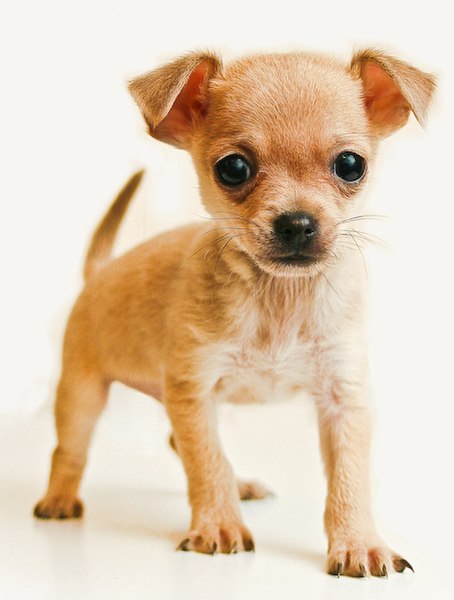 |
| Chihuahua dog puppy |
The About this sound Chihuahua (help·info) (Spanish: Chihuahueño) is the smallest breed of dog and is named after the state of Chihuahua in Mexico.
History
Both folklore and archeological finds show that the breed originated in Mexico. The most common theory and most likely is that Chihuahuas are descended from the Techichi, a companion dog favored by the Toltec civilization in Mexico.
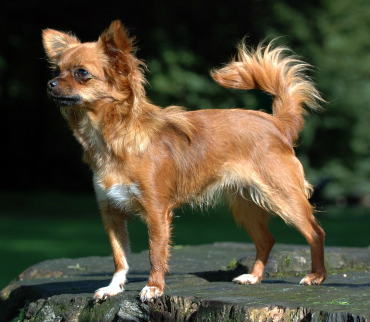 |
| Brown Chihuahua |
Historical records indicate that the Techichi hunted in packs. They can only be traced as far back as the ninth century but it is highly likely that this is the Chihuahua's native Mexican ancestor[citation needed]. Evidence of this is that the remains of dogs closely resembling, but slightly larger than the average Chihuahua have been found in such places as the Great Pyramid of Cholula, which dates back to the 2nd century BC and predates the 16th century. There is also evidence to suggest that the Techichi may also predate the Mayans.
The Toltecs were conquered by the Aztecs, who believed that the Techichi held mystical powers.[2] In terms of size, the present day Chihuahua is much smaller than its ancestors, a change thought to be due to the introduction of miniaturized Chinese dogs, such as the Chinese Crested Dog, into South America by the Spanish.
A progenitor of the breed was reputedly found in 1850 in old ruins near Casas Grandes in the Mexican state of Chihuahua from which the breed gets its name. The state borders with Texas, Arizona and New Mexico where Chihuahuas first rose to prominence and were further developed in the United States. Since that time, the Chihuahua has remained consistently popular as a breed, particularly in America when the breed was first recognized by the American Kennel Club in 1904. Genetic tests place the Chihuahua with other modern breeds originating in the 1800s.
The Toltecs were conquered by the Aztecs, who believed that the Techichi held mystical powers.[2] In terms of size, the present day Chihuahua is much smaller than its ancestors, a change thought to be due to the introduction of miniaturized Chinese dogs, such as the Chinese Crested Dog, into South America by the Spanish.
A progenitor of the breed was reputedly found in 1850 in old ruins near Casas Grandes in the Mexican state of Chihuahua from which the breed gets its name. The state borders with Texas, Arizona and New Mexico where Chihuahuas first rose to prominence and were further developed in the United States. Since that time, the Chihuahua has remained consistently popular as a breed, particularly in America when the breed was first recognized by the American Kennel Club in 1904. Genetic tests place the Chihuahua with other modern breeds originating in the 1800s.
Description and standards
 |
| happy |
Breed standards for this dog do not generally specify a height, only a weight and a description of their overall proportions. As a result, height varies more than within many other breeds. Generally, the height ranges between six and ten inches. However, some dogs grow as tall as 12 to 15 inches (30 to 38 cm). Both British and American breed standards state that a Chihuahua must not weigh more than six pounds for conformation. However, the British standard also states that a weight of two to four pounds is preferred and that if two dogs are equally good in type, the more diminutive or smaller is preferred. The Fédération Cynologique Internationale (FCI) standard calls for dogs ideally between 1.5 and 3.0 kg (3.3 to 6.6 lbs.), although smaller ones are acceptable in the show ring.
 |
| Puppy |
Pet-quality Chihuahuas (that is, those bred or purchased as companions rather than show dogs) often range above these weights, even above ten pounds if they have large bone structures or are allowed to become overweight. This does not mean that they are not purebred Chihuahuas; they do not meet the requirements to enter a conformation show. Oversize Chihuahuas are seen in some of the best, and worst, bloodlines. Typically the breed standard for both the long and short coat chihuahua will be identical except for the description of the coat.
Chihuahua breeders often use terms like miniature, teacup, tiny toy, apple headed, or deer headed, to describe puppies. These terms are not recognized by the breed standards and may be misleading.
Coat
 |
| Female Chihuahua with cute look |
The Kennel Club in the United Kingdom and the American Kennel Club in the United States only recognize two varieties of Chihuahua: the long-coat, the smooth-coat, also referred to as short-haired.They are genetically the same breed. The term smooth-coat does not mean that the hair is necessarily smooth, as the hair can range from having a velvet touch to a whiskery feeling. Long-haired Chihuahuas are actually smoother to the touch, having soft, fine guard hairs and a downy undercoat, which gives them their fluffy appearance. Unlike many long-haired breeds, long-haired Chihuahuas require no trimming and minimal grooming. Contrary to popular belief, the long-haired breed also typically sheds less than their short-haired counterparts. It may take up to two or more years before a full long-haired coat develops.
Colors
The American Kennel Club Chihuahua standard lists under color: "Any color-Solid, marked or splashed". This allows for all colors from solid blacks to solid whites, spotted, sabled, or a variety of other colors and patterns. A few examples are Fawn, Red, Cream, Chocolate, Blue, and Black. Merle coloring is a spotted coat. Patterns, all with or without white markings, include:
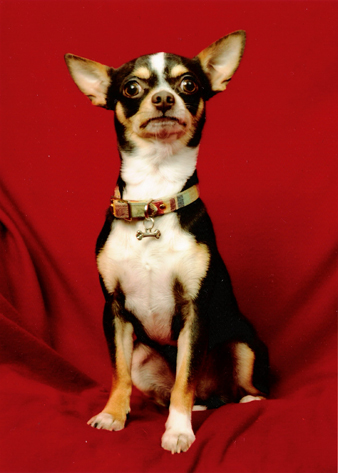 |
| Black and tan Chihuahua dog |
* Irish spotting
* Dalmatian spotting
* Piebald spotting
* Extreme black spotting
* Brindle
* Masks
* Tan points
* Red
* White
* Black
* Merle
* Orange
* Fawn
* Tricolor
The merle coat pattern is not traditionally considered part of the breed standard. It is associated with genetic
 |
| Brown and white Chihuahua dog |
diseases usually associated with inbreeding in other breeds. The United Kingdom Kennel Club decided in May 2007 not to register puppies with "Merle coat color in dogs" coloration due to the health risks associated with the gene responsible, and in December of that year formally amended the Breed Standard to say "Any color or mixture of colors but never merle (dapple)." Other countries' Kennel Clubs; including Canada, Australia, New Zealand, and Germany have also disqualified merle. However, in May 2008 the Chihuahua Club of America voted that merles will not be disqualified in the United States and they are fully registrable and able to compete in all American Kennel Club (AKC) events. Opponents of recognizing merle dogs in the breed standards suspect the coloration came about by modern genetic cross-breeding with other dogs, and not via natural genetic drift.
Classifying Chihuahua colors can be complicated due to the large number of possibilities. Examples would be a blue brindle or a chocolate and tan. Colors and patterns can combine and affect each other, resulting in a very high degree of variation. The classic Chihuahua color remains fawn. No color or pattern is considered more valuable than the others, although blue is considered rare.
Classifying Chihuahua colors can be complicated due to the large number of possibilities. Examples would be a blue brindle or a chocolate and tan. Colors and patterns can combine and affect each other, resulting in a very high degree of variation. The classic Chihuahua color remains fawn. No color or pattern is considered more valuable than the others, although blue is considered rare.
Temperament
Being naturally territorial and protective, Chihuahuas can be easily provoked to attack, and are therefore generally unsuitable for homes with small children. A Chihuahua who is pack leader of their humans may snap at children. This breed is generally not recommended for children, not because they are not good with them, but because most people treat the Chihuahua differently than they would a large dog, causing them to become untrustworthy. The AKC describes the breed as, "A graceful, alert, swift-moving little dog with saucy expression, compact, and with terrier-like qualities of temperament." The breed tends to be fiercely loyal to one particular owner, but may be attached to more. They do not always get along with other breeds. These traits generally make them unsuitable for households with children that are not patient and calm.
 |
| Aggressive Chihuahua |
Chihuahuas crave attention, affection, exercise and being petted.[citation needed] They can be hyper, but eager to please. They have a reputation as a "yappy" dog, which can be resolved with proper training. Chihuahuas with proper breeding are not "yappy"; the AKC standard calls for "a terrier-like attitude."Long haired chihuahuas tend to have a more mellow temperament.
Chihuahuas are not well-suited as small children's pets because of their size, temperament, and tendency to bite when frightened. It is recommended that children be school age or older before adding a Chihuahua to one's home. Also, many Chihuahuas focus their devotion on one person, becoming overly jealous of that person's human relationships. This can be mitigated through socialization. Chihuahuas also tend to have a "clannish" nature, often preferring the companionship of other Chihuahuas over other dogs.
Chihuahuas are not well-suited as small children's pets because of their size, temperament, and tendency to bite when frightened. It is recommended that children be school age or older before adding a Chihuahua to one's home. Also, many Chihuahuas focus their devotion on one person, becoming overly jealous of that person's human relationships. This can be mitigated through socialization. Chihuahuas also tend to have a "clannish" nature, often preferring the companionship of other Chihuahuas over other dogs.
Health disorders
This breed requires expert veterinary attention in areas such as birthing and dental care. Chihuahuas are also prone to some genetic anomalies, often neurological ones, such as epilepsy and seizure disorders.
Chihuahuas, and other toy breeds, are prone to the sometimes painful disease, hydrocephalus. It is often diagnosed by the puppy having an abnormally large head during the first several months of life, but other symptoms are more noticeable (since "a large head" is such a broad description). Chihuahua puppies exhibiting hydrocephalus usually have patchy skull platelets rather than a solid bone and typically are lethargic and do not grow at the same pace as their siblings. A true case of hydrocephalus can be diagnosed by a veterinarian, though the prognosis is grim.
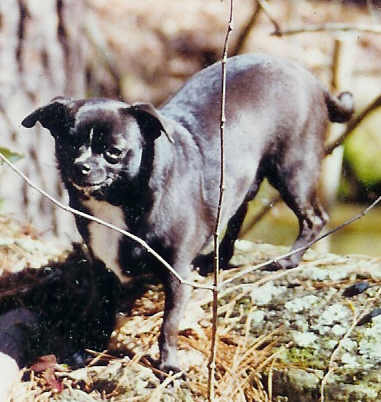 |
| Black Chihuahua |
Chihuahuas have moleras, or a soft spot in their skulls, and they are the only breed of dog to be born with an incomplete skull. The molera fills in with age, but great care needs to be taken during the first six months until the skull is fully formed. Some moleras do not close completely and will require extra care to prevent injury. Many veterinarians are not familiar with Chihuahuas as a breed, and mistakenly confuse a molera with hydrocephalus. The Chihuahua Club of America has issued a statement regarding this often deadly misdiagnosis.
Chihuahuas can also be at risk for hypoglycemia, or low blood sugar. This is especially dangerous for puppies. Left unattended, hypoglycemia can lead to coma and death. This can be combated with frequent feedings (every three hours for very small or young puppies). Chihuahua owners should have a simple sugar supplement on hand to use in emergencies, such as, Nutri-Cal, Karo syrup or honey. These supplements can be rubbed on the gums and roof of the mouth to rapidly raise the blood sugar level. Signs of hypoglycemia include lethargy, sleepiness, low energy, uncoordinated walking, unfocused eyes and spasms of the neck muscles (or head pulling back or to the side).
Chihuahuas are prone to eye infections or eye injury due to their large, round, protruding eyes and their relatively low ground clearance. Care should be taken to prevent visitors or children from poking the eyes. The eyes also water to remove dust or allergens that may get into the eye. Daily wiping will keep the eyes clean and prevent tear staining. Chihuahuas have a tendency to tremble but this is not a health issue, rather it takes place when the dog is stressed, excited or cold. One reason for this may be because small dogs have a higher metabolism than larger dogs and therefore dissipate heat faster. Due to this Chihuahuas often wear coats or sweaters when outside in the cold or in overly air-conditioned places. Chihuahuas often like to dig and snuggle down in blankets for sleeping.
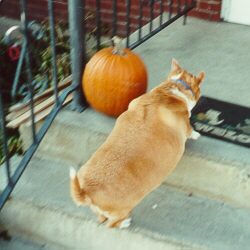 |
| Orange Chihuahua |
Although figures often vary, as with any breed, the average lifespan range for a healthy Chihuahua is approximately 10 to 17 years.
Chihuahuas are sometimes picky eaters, and care must be taken to provide them with adequate nutrition. Chihuahuas could earn this reputation because they seem to find small unnoticed bits of food all day. Sometimes wet or fresh food can have the most appealing smell to these constant eaters. "They will eat when they are hungry" does not apply as Chihuahuas are prone to hypoglycemia and could be at a critical state if allowed to go too long without a meal. At the same time, care must be exercised not to overfeed them. Human food should be avoided. Due to their small size even tiny high fat or sugary treats can result in an overweight Chihuahua. Overweight Chihuahuas are susceptible to having an increased rate of joint injuries, tracheal collapse, chronic bronchitis, and shortened life span.
Chihuahuas are sometimes picky eaters, and care must be taken to provide them with adequate nutrition. Chihuahuas could earn this reputation because they seem to find small unnoticed bits of food all day. Sometimes wet or fresh food can have the most appealing smell to these constant eaters. "They will eat when they are hungry" does not apply as Chihuahuas are prone to hypoglycemia and could be at a critical state if allowed to go too long without a meal. At the same time, care must be exercised not to overfeed them. Human food should be avoided. Due to their small size even tiny high fat or sugary treats can result in an overweight Chihuahua. Overweight Chihuahuas are susceptible to having an increased rate of joint injuries, tracheal collapse, chronic bronchitis, and shortened life span.







